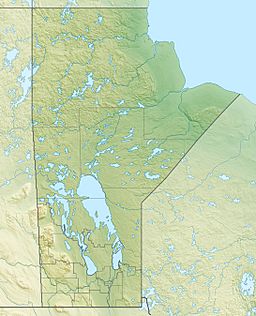Little Limestone Lake facts for kids
Quick facts for kids Little Limestone Lake |
|
|---|---|

Little Limestone Lake
|
|
| Location | Little Limestone Lake Provincial Park, Manitoba, Canada |
| Coordinates | 53°47′N 99°19′W / 53.783°N 99.317°W |
| Type | lake |
Little Limestone Lake is a truly special lake found in Little Limestone Lake Provincial Park in northern Manitoba, Canada. It is about 500 kilometers (310 miles) north of Winnipeg. This unique lake is also about 65 kilometers (40 miles) north of the town of Grand Rapids, Manitoba.
The lake is part of the Little Limestone Lake Park Reserve. This area covers about 4,095 hectares (10,120 acres). It is a great example of karst geology, which means the land has been shaped by dissolving rocks, often creating caves and sinkholes. The eastern shore of the lake is part of the traditional lands of the Mosakahiken Cree Nation. Little Limestone Lake Park Reserve is a protected area recognized by the IUCN (World Conservation Union). It is protected mainly because it has a very special natural feature.
Contents
What Makes Little Limestone Lake Special?
Little Limestone Lake is known as the largest and most amazing example of a marl lake in the world. It has a beautiful turquoise color. What makes it truly unique is that its color changes! This happens because of a substance called calcite in the water.
The Amazing Color Change
The lake's color changes depending on the water temperature. When the water gets warmer, calcite starts to come out of the water. It forms tiny, microscopic crystals. These tiny crystals make the water look milky white. This is why the lake can change from clear turquoise to a milky blue or white.
The calcite comes from underground water. This water flows into the lake in large amounts. As the water warms up, the calcite that was dissolved in it becomes solid again. This process is called "precipitation." It is like sugar dissolving in hot tea, but then forming crystals if the tea cools down too much.
What is a Marl Lake?
A marl lake is a lake that has a lot of calcium carbonate. This is a mineral, similar to chalk or limestone. In marl lakes, this mineral often forms a soft, muddy deposit at the bottom. The unique conditions in Little Limestone Lake, especially the flow of underground water and temperature changes, make it a perfect place for calcite to form and change the water's appearance.
Protecting This Unique Place
Little Limestone Lake is very important. It is protected to make sure its unique features last for a long time. The Little Limestone Lake Provincial Park helps to preserve this special environment. Protecting areas like this helps scientists study natural processes. It also allows people to enjoy the beauty of nature.


